Become a Partner
Add OffSec to your list of training providers
Partner with us
OffSec Wins Seven Global InfoSec Awards during RSA Conference 2024
Read blogSecure software development is a comprehensive approach to building software applications with a strong focus on protecting sensitive data and preventing security breaches. It involves integrating security measures from the very beginning of the development process, ensuring that security considerations are woven into the fabric of the application. Secure software development encompasses a set of best practices, coding standards, and principles that address common security threats and vulnerabilities.
The three fundamental principles that guide software development maintain the confidentiality, integrity, and availability of software applications while ensuring that they remain resilient to attacks and vulnerabilities.
An essential principle that involves integrating security into the software design process from the ground up. In secure by design, security is not considered an afterthought or add-on, but an essential aspect of the design process.
A fundamental aspect of secure software development that grants users the absolute minimum level of access required to execute their tasks. Developers can ensure that the least privilege principle is adhered to by granting users access to system resources based on their functional roles and responsibilities. By limiting access, the potential impact of any security breaches or unauthorized access is minimized.
A principle of secure software development that emphasizes a layered approach to system security. In defense in depth, security is implemented by using multiple layers of protection where if one security layer fails, there are others in place to help mitigate and control the damage. These protection layers can include firewalls, access controls, intrusion detection systems, and security monitoring systems, among others.
OffSec’s secure software development training empowers developers to build and deploy secure software from the start to prevent vulnerabilities, and security professionals to gain an understanding of the software development process.
Secure coding practices are a set of guidelines and techniques that developers follow to write software code that is resistant to common security vulnerabilities. These practices encompass various aspects of coding, including input validation, secure authentication, secure session management, and secure communication. By incorporating secure coding practices, developers can significantly reduce the risk of introducing security vulnerabilities into their software applications.
Input validation is one of the most fundamental secure coding practices that involves validating and sanitizing user inputs to prevent malicious inputs from introducing code in a system. Checking input data for its size, type, format, and other characteristics is critical in blocking various attacks like injection attacks.
Authentication is a critical component of securing software applications, and strong authentication mechanisms ensure that the right people have access to the right data. Developers can follow secure coding practices by ensuring that passwords are stored securely, hashed with appropriate algorithms such as bcrypt, and using session tokens or cookies for maintaining authenticated sessions.
Secure session management involves proper handling of user sessions such that they remain valid while in use but expire when no longer in use. Maintaining user sessions securely is crucial in safeguarding user data as well as protecting against session hijacking. Developers can follow best practices by ensuring that session cookies are randomly generated, are sufficiently long, and employ secure encryption.
Secure communication is essential to ensure that data transmitted over networks remains confidential, and cannot be modified by unauthorized persons. Secure communication can be achieved by using appropriate encryption techniques, such as SSL/TLS or AES encryption. Developers can use standardized encryption libraries to ensure secure communication in their applications.
Proper error handling is an important aspect of secure software development. Error messages should not reveal sensitive information and should be helpful to users. Error messages that provide too much detail can be exploited by attackers to uncover vulnerabilities in the system. Additionally, error messages should be used in meaningful situations only, where they can be helpful to users and reduce confusion.
The Secure Software Development Lifecycle (SDLC) is a standardized process that guides software development teams in building secure software applications. Integrating security into each phase of the SDLC helps ensure that the final software product is secure, reliable, and trustworthy. Here are the five main phases of the SDLC with a focus on security:
01
In the planning phase of the SDLC, the development team outlines the software's scope and objectives. Security is integrated into this phase by considering security risks and establishing security requirements for the application. Security requirements can include access control mechanisms, threat modeling, authentication protocols, and encryption requirements.
02
During the design phase, developers create a detailed architectural plan for the application. Secure coding principles, such as secure by design, are integrated into this phase to ensure that security is part of the software's design. The design phase also includes setting up security protocols like Transport Layer Security (TLS) and network encryption.
03
In the implementation phase, developers write the code and incorporate secure coding practices like input validation and proper error handling. Developers can use code analysis tools for secure coding practices and identify vulnerabilities before the code is deployed. Code reviews and testing tools can ensure that the code adheres to security standards.
04
In this phase, developers test the code for functionality, performance, and security. Security testing techniques focus on discovering vulnerabilities in the software application, such as penetration testing and vulnerability scanning, to identify security flaws in the application.
05
During this phase, developers deploy the software application and ensure that the environment in which the application operates meets the necessary security requirements. Security is integrated into this phase by ensuring that access controls and network security mechanisms, such as firewalls, are in place.
Secure software development training is crucial not only for developers but also for security practitioners to gain a comprehensive understanding of the software development process.
For developers, this training is essential to ensure they have the knowledge and skills to incorporate security practices and principles into their code from the very beginning. By understanding secure coding techniques, developers can proactively identify vulnerabilities and implement robust security measures, thereby minimizing the risk of potential breaches or exploits
Security practitioners also benefit from software development training as it enables them to effectively collaborate with developers. By acquiring knowledge about the software development process, security practitioners can better comprehend the inherent challenges and complexities involved in building secure code. This understanding allows them to provide more accurate guidance and recommendations to developers, bridging the gap between security and development teams.
Furthermore, secure software development training fosters a culture of security awareness and accountability across an organization. By training both developers and security practitioners, a shared language and set of best practices are established, promoting effective collaboration and communication. This, in turn, leads to the creation of more secure software solutions and a stronger overall security posture for the organization.
OffSec is a globally recognized and trusted provider of industry-leading cybersecurity training and certification programs. Among the comprehensive suite of learning paths that help learners adopt basic cybersecurity-adjacent concepts and cultivate the mindset necessary for a successful cybersecurity career, OffSec offers secure software development training for developers and security practitioners. Organizations worldwide turn to OffSec to enhance the skills and capabilities of their cybersecurity and developer teams in the following ways:
OffSec offers comprehensive and hands-on learning paths, such as:
SSD: Secure Software Development, designed for roles such as Security Software Engineer, Applications Engineer, Release Manager, Software Developer, or anyone committed to the defense or security of enterprise applications. Through a combination of content on language-agnostic secure coding principles, videos, and practical, real-world exercises, every development team will build skills applicable to a broad range of web technologies.
At OffSec, we offer courses and learning paths for teams and individuals at all skill levels. Our courses and learning paths are designed to support ongoing professional development, allowing developers and cybersecurity teams to continuously enhance their skills. Our training programs enable organizations to establish a culture of continuous learning and improvement within their development teams. By investing in our training, organizations give their teams the necessary resources and support to stay up-to-date with the latest industry trends and best practices in secure software development.
By participating in OffSec's training programs, organizations gain access to a global community of like-minded professionals. This community provides valuable networking opportunities, knowledge sharing, and support channels. Organizations can leverage this community to exchange ideas, collaborate on challenging problems, and stay connected with the latest trends and best practices in the software development field.
Get a quote
Unlimited Learning Library and Enterprise Cyber Range access, plus reassign licenses as needed.

